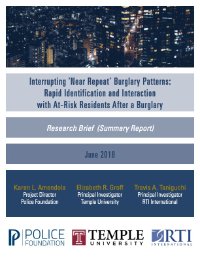By Elizabeth. Groff and Travis Taniguchi
According to the FBI, there were over 1.5 million burglaries in the U.S. in 2016, with almost 70% residential (FBI, 2017a). Combined, the victims of burglary suffered over $3.6 billion in lost property (about $2,400/burglary). Yet, only about 13% of burglaries reported to the police were cleared (FBI, 2017b). While more prevalent than violent crime, burglary rarely generates attention and headlines. Yet, the sense of violation and vulnerability typical of residential burglary victims is considerable, and so prevention would seem the best solution. The Near Repeat Phenomenon The biggest challenge facing crime prevention in policing is the need to correctly anticipate where and when crime will occur (Pease & Laycock, 1999). Hot spots policing focuses on the locations where crimes occur frequently, though knowing when they will occur can help law enforcement effectively deploy personnel. Repeat victimization occurs when the same target is victimized again. However, the “Near Repeat” (NR) phenomenon (Morgan, 2001) is when those that live near to a burglary victim are victimized soon after; in other words, when one home is burglarized, for a particular time period afterwards, homes nearby are at an elevated risk of burglary. Empirical research has clearly confirmed the existence of NR burglary patterns. The exact spatial and temporal extent of increased risk varies; however, we know the increased risk level that occurs after a burglary is temporary, suggesting police must act quickly to maximize the potential for reaping crime prevention benefits.
Washington, DC: Police Foundation, 2018. 14p.



